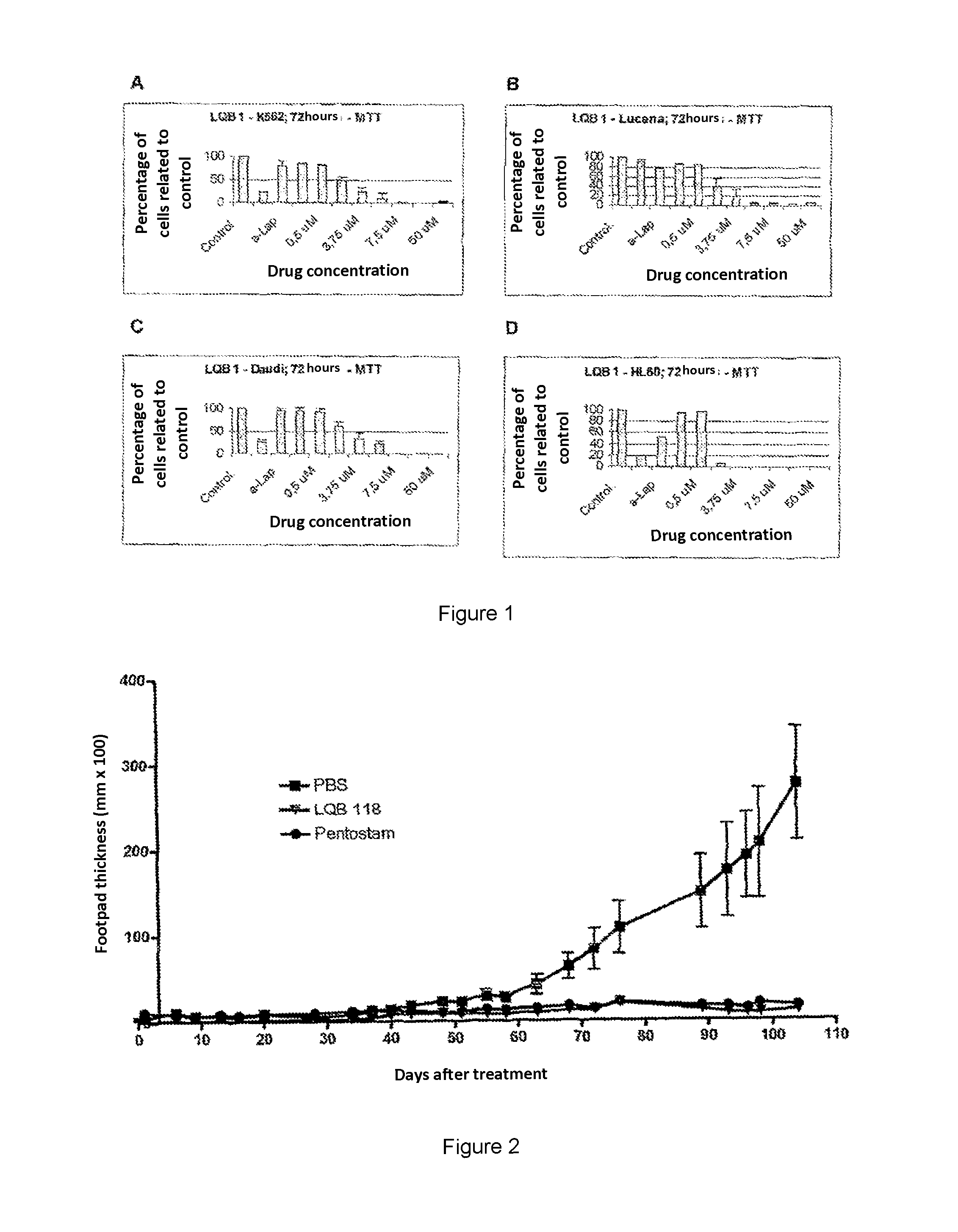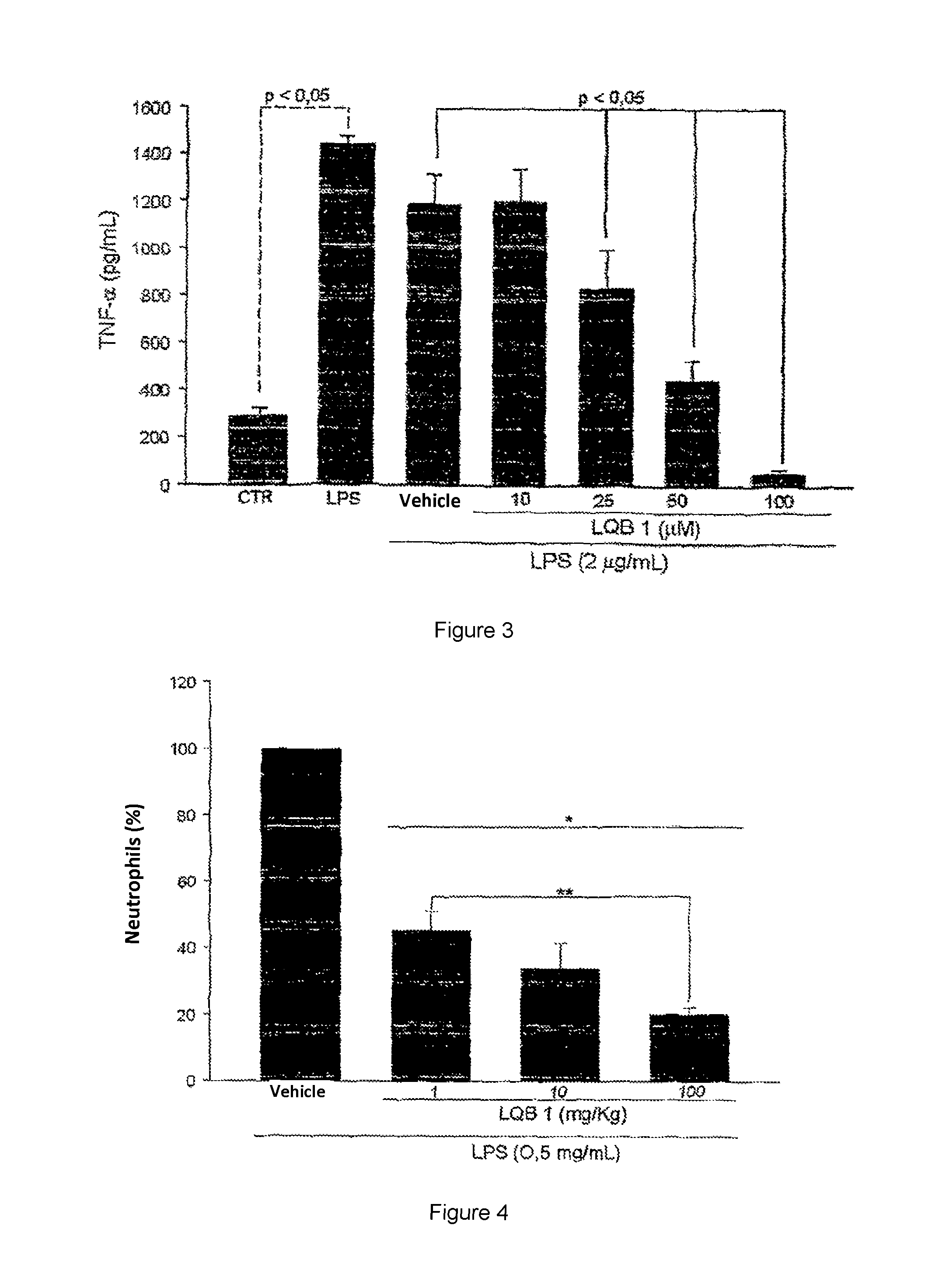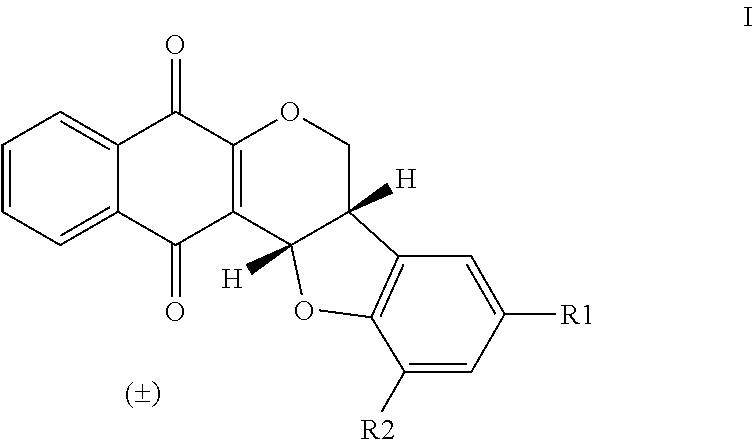Compounds of the pterocarpanquinone family, method for preparing the same, pharmaceutical composition containing the new compounds of the pterocarpanquinone family, uses and therapeutic method
a technology of pterocarpanquinone and compound, applied in the field of chemical pharmaceuticals, can solve the problems of indiscriminately affecting all strata of society, cancer is a major public, and the therapeutic advances are much more modest, and achieve the effect of inhibiting the release of tnf- and inhibiting the release of neutrophils
- Summary
- Abstract
- Description
- Claims
- Application Information
AI Technical Summary
Benefits of technology
Problems solved by technology
Method used
Image
Examples
example 1
New Pterocarpanquinone Produced by Formula (I)
[0133]
Formula (I)CompoundR1R2R3LQB1HH—LQB2NO2H—LQB3NH2H—LQB4CO2R3HCH3LQB5CO2R3HHLQB6CO2R3HNaLQB7CH2OHH—LQB8CHOH3CO—LQB9CO2R3H3CONaLQB10ClH—LQB11BrH—
example 2
Synthesis of Compounds of Formula (I)
2.1—Synthesis of Intermediate 1 (a-dehydro-desmethyl-lapachone)
[0134]Lawsone solution (1.0 g, 5.74 mmol), acrolein (13.2 mL), phenyl boronic acid (0.7 g, 5.74 mmol) and glacial acetic acid (26.4 mL) in toluene (210.0 mL) was refluxed for 6 hours. The product formation was monitored by TLC. The reaction mixture was cooled, concentrated in a rotary evaporator and extracted with ethyl acetate. The organic extract was washed successively with NaHCO3 and saturated NaCl solution, dried on Na2SO4 and the solvent evaporated. The crude material was purified by column chromatography giving a red solid (0.6 g, 50% yield), fp=215-217° C.
2.1—Synthesis of LQBs
[0135]Synthesis of LQB1 by a solution of chromenequinone (106 mg, 0.5 mmol) in acetone (50 mL) under stirring. Were added 83 mg of o-iodophenol (0.75 mmol), 413 mg Ag2CO3 (1.5 mmol), 26.2 mg of PPh3 (0.1 mmol, 20 mol %) and 11.2 mg of (AcO)2Pd (0.05 mmol, 10 mol %). The reaction mixture was refluxed for 1...
example 3
Clinical Trials
3.1—Cancer
3.1.1—Cell Lines and Cell Culture
[0139]It was used the established cell lines K562, Lucena-1, Daudi, Raji, Jurkat and HL-60. The cells are grown in bottles of 25 cm3, 5 mL of RPMI medium supplemented with 10% fetal calf serum (FCS). The number of cells was counted by light microscopy in a Neubauer chamber and adjusted to a concentration of 2×104 cells / mL before the bells. (held twice a week) For the Jurkat line, the amount of cells was adjusted to 2×105 cells / mL. The strain named Lucena-1 was selected from a sample of K562, which was exposed to increasing concentrations of VCR, starting by 3 nM up to 60 nM, from which the surviving cells were maintained. In addition to the culture field and FBS, for Lucena-1 cultures, 60 nM of VCR were added. The cultures are incubated in 5% CO2 at 37° C.
3.1.2—Measurement of Cell Viability
[0140]In order to measure cell viability after incubation with synthetic pterocarpanes, leukemic cells were tested using the MTT colorimet...
PUM
| Property | Measurement | Unit |
|---|---|---|
| period of time | aaaaa | aaaaa |
| time | aaaaa | aaaaa |
| concentration | aaaaa | aaaaa |
Abstract
Description
Claims
Application Information
 Login to View More
Login to View More - R&D
- Intellectual Property
- Life Sciences
- Materials
- Tech Scout
- Unparalleled Data Quality
- Higher Quality Content
- 60% Fewer Hallucinations
Browse by: Latest US Patents, China's latest patents, Technical Efficacy Thesaurus, Application Domain, Technology Topic, Popular Technical Reports.
© 2025 PatSnap. All rights reserved.Legal|Privacy policy|Modern Slavery Act Transparency Statement|Sitemap|About US| Contact US: help@patsnap.com



